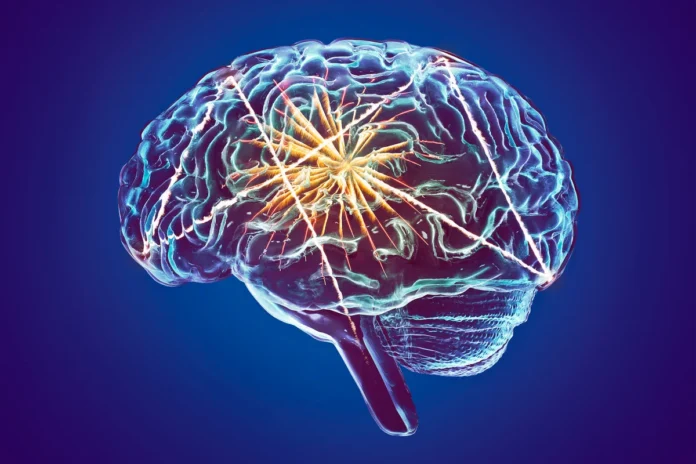November 8, 2024
A mysterious electromagnetic mechanism may be more important than the firing of neurons in our brain to explain our awareness
Hiroshi Watanabe/Getty Images
The neuron, the specialized cell type that makes up much of our brains, is at the center of today’s neuroscience. Neuroscientists explain perception, memory, cognition and even consciousness itself as products of billions of these tiny neurons busily firing their tiny “spikes” of voltage inside our brain.
These energetic spikes not only convey things like pain and other sensory information to our conscious mind, but they are also in theory able to explain every detail of our complex consciousness.
At least in principle. The details of this “neural code” have yet to be worked out.
While neuroscientists have long focused on spikes travelling throughout brain cells, “ephaptic” field effects may really be the primary mechanism for consciousness and cognition. These effects, resulting from the electric fields produced by neurons rather than their synaptic firings, may play a leading role in our mind’s workings.
In 1943 American scientists first described what is known today as the neural code, or spike code. They fleshed out a detailed map of how logical operations can be completed with the “all or none” nature of neural firing—similar to how today’s computers work. Since then neuroscientists around the world have engaged in a vast endeavor to crack the neural code in order to understand the specifics of cognition and consciousness—to little avail.
“The most obvious chasm in our understanding is in all the things we did not meet on our journey from your eye to your hand,” confessed neuroscientist Mark Humphries in 2020’s The Spike, a deep dive into this journey: “All the things of the mind I’ve not been able to tell you about, because we know so little of what spikes do to make them.”
Brain researchers have long acknowledged that there are a number of ways other than firing by which neurons could communicate, including the little-known mechanism known as ephaptic coupling. This coupling results from electromagnetic (EM) fields at the medium and large scales of the brain interacting, alongside much smaller scale fields accompanying synaptic spikes (which themselves result from a type of highly localized EM field activity) operating at nanometer scales.
The “ephaptic” in ephaptic coupling simply means “touching.” Though not well-known, ephaptic field effects result from the textbook electric and magnetic interactions that power our cells. Intriguing experimental results suggest these same forces play a bigger role in the brain than one suspected and perhaps even in consciousness.
Ephaptic field effects first came to my attention in a significant way with a remarkable 2019 paper from the Case Western Reserve University laboratory of Dominique Durand. That lab demonstrated that the mouse cortex was affected without synaptic connections—by definition, ephaptic field interactions. This remarkable effect was found by the Durand team after they cut a slice of mouse hippocampus in half and then measured the voltage potential going up and down the slice. There was almost no change in that measured voltage even after the slice was fully severed, demonstrating a strong influence from ephaptic fields.
The influence did, they found, wane after a certain distance, as we’d expect. Once the cut slices were separated by 400 microns or more, the ephaptic field effect mostly disappeared.
These results were considered so remarkable by peer reviewers that they required the Durand lab to replicate the results not once but twice before they approved publication of the paper. One scholar stated at the time of the paper’s publication that the findings of Chiang and colleagues “should probably (and quite literally) electrify the field.”
Another team compared the speed of ephaptic field effects in various tissues, finding that the speed of propagation of ephaptic fields in gray matter is about 5,000 times faster than neural firing.
This means that what would take normal spike pathways one second to span through the brain, could be traversed 5,000 times during that same time interval with ephaptic effects. If we cube this over the volume of the brain we get an information density up to a staggering 125 billion times more from ephaptic fields than from synaptic firing.
A key caveat to this statement is to stress that this is potential information density only, and it is not necessarily the case that this potential can actually be reached. More research will need to be done to see how much of this vast ephaptic potential is realized by our brains.
Abundant evidence shows that synaptic firing is essential for moving, hearing, touching and much else, but given the vastly greater information density in the ephaptic fields, and the pervasiveness of ephaptic field effects, it would be exceedingly strange if evolution hadn’t grasped upon this effect for important brain functions. Indeed, it seems that she has, in sundry ways.
Walter Freeman, a legendary now-deceased neuroscientist from the University of California, Berkeley, stated in a 2006 paper that traditional synaptic firing speeds could not explain the speed of cognitive functions he had observed over the years in rabbits and cats.
Instead the recent spate of ephaptic effects findings suggest a solid mechanism to explain these speeds. Our recent theoretical paper, building on these findings, suggested that ephaptic field effects may in fact be the primary mechanism for consciousness and cognition, rather than neural firing.
Another recent paper including as authors the University of California, Los Angeles’s Costas Anastassiou and former Caltech neuroscientist Christof Koch, provides strong support for the importance of ephaptic effects. They find that, indeed, ephaptic coupling can explain the “fast coordination” required for consciousness “even in the absence of very fast synapses.”
This single paper could take the field of ephaptic field science from the fringes of neuroscience to the forefront. Its findings regarding the speed and pervasiveness of ephaptic field effects may presage a fundamentally new understanding of how cognition and consciousness work.
This is an opinion and analysis article, and the views expressed by the author or authors are not necessarily those of Scientific American.




